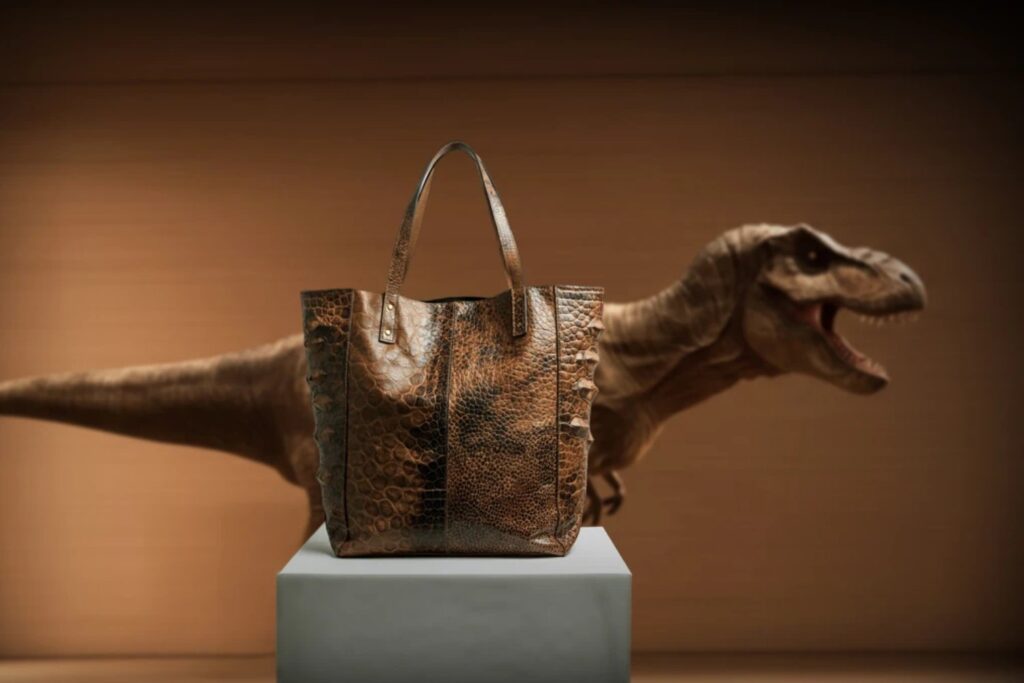Three companies have joined forces to develop a new luxury alternative to traditional leather. That sounds ordinary—except the material they’re trying to create is anything but.
On Friday, April 25, creative agency VML and biotech companies Lab-Grown Leather Ltd. and The Organoid Company announced a “first-of-its-kind” partnership. Their goal: to create a cruelty-free, environmentally friendly, high-quality alternative to traditional leather, purportedly using Tyrannosaurus rex DNA. According to a company statement, the partnership aims to harness “the biology of the past to create the luxury materials of the future.” The catch is that they haven’t sufficiently explained exactly how they’re going to do that—and some researchers are very skeptical.
“Using fossilized T-Rex collagen as a blueprint, the production process will involve engineering cells with synthetic DNA,” according to the statement. “Unlike other bio-based alternatives, Lab-Grown Leather’s ‘scaffold-free’ approach allows cells to create their own natural structure, resulting in a material that is structurally identical to traditional leather.”
Collagen is an abundant protein in all animals, and provides structural support to muscles, bones, skin, and connective tissues. While researchers have recovered bits of collagen up to 195 million years old from dinosaur fossils and other remains, DNA decays much more rapidly. That means scientists can’t study dinosaur DNA directly—they have to reconstruct it in other ways.
VML did not respond to a request from Gizmodo for clarification on its process. According to The Times, however, the researchers plan to use artificial intelligence to create a replica of T. rex collagen from preserved collagen fragments.
Collagen, like all proteins, is made of amino acids whose sequences are determined by the order of nucleotide bases in DNA—the genetic code, or a gene’s “instructions” for how to make a specific protein.
In an email to Gizmodo, Christina Agapakis—a synthetic biologist with a PhD from Harvard Medical School and founder of the design service company Oscillator—said she believes the researchers might be using the collagen sequence to work backward and reconstruct the DNA that codes for the protein.
Whether or not the researchers take this approach, they plan to insert the collagen-building DNA into cells, which will—supposedly—turn into T. rex skin, according to the Lab-Grown Leather website. In tissue engineering, scaffolds are materials that provide structural support for cells as the tissue develops. By growing without this structure, the companies seem to suggest that the final material will be exactly like natural leather.
According to Agapakis, researchers have previously tried to recreate leather from cells, including a Victimless Leather jacket prototype from 2004. Because “producing leather at any scale from cells has remained stubbornly difficult,” Agapakis said she is excited to see their results and learn about the process.
There’s just one problem. “You can’t make leather from collagen,” Mary Higby Schweitzer, a molecular paleontologist from North Carolina State University, told Gizmodo. “Leather is tanned from skin,” she added, which mostly consists of “epithelial tissues. These are made of keratin in all terrestrial vertebrates.”
More broadly, Schweitzer, who’s not involved with the project, said that if she was trying to make dinosaur leather, she wouldn’t start with the T. rex, since preserved skin samples of theropods are extremely rare. Specifically, “I wouldn’t start with T. rex collagen, which you’ll notice they didn’t mention how they got that or which T. rex it came from,” Schweitzer said. “The idea is kind of cool, but I don’t think this press release is very accurate.” To which she added: “It would be wrong to call it T. rex leather.”
Nevertheless, one could still argue that bio-engineered leather—however it’s made—is better than traditional leather, an industry linked to deforestation and substantial greenhouse gas emissions. But consumers with sustainability in mind could simply opt for a thrifted handbag, or one made from recycled material, as Agapakis pointed out.
Still, the novelty of such an item appeals to Agapakis. “If I want something awesome—in the true meaning of the word—I’d go with a lab-grown leather using sequences of collagen from a 68-million-year-old T-Rex tissue sample,” she said, adding that such projects don’t have to be practical to be worthwhile. “I think there’s a lot more to this than ‘sustainability.’”
The companies plan to start with fashion accessories, then scale up to a luxury flagship product by the end of the year. Down the line, they hope to bring their alternative leather into other sectors, including the automotive industry.
This latest partnership brings a similar project—and controversy—to mind. Last month, biotech company Colossal Biosciences claimed to have brought back extinct dire wolves. The announcement sparked an intense debate about whether the pups are real dire wolves, or just genetically modified gray wolves.
Skepticism is understandably emerging about whether VML, Lab-Grown Leather Ltd., and The Organoid Company’s alternative leather will truly be reconstructed T. rex skin, or just dinosaur-inspired lab-grown leather. If anything, both projects reflect a growing trend of companies using science to legitimize ideas that might have been compelling on their own—only to be overshadowed by questionable claims.

